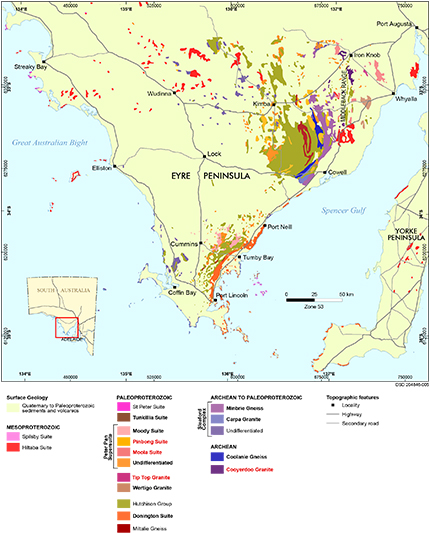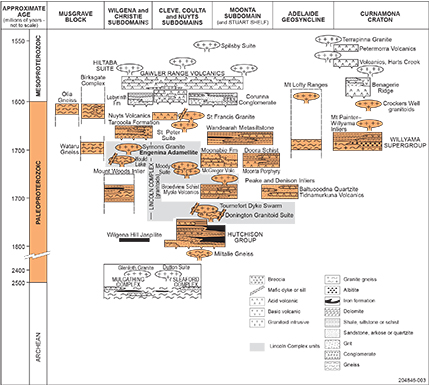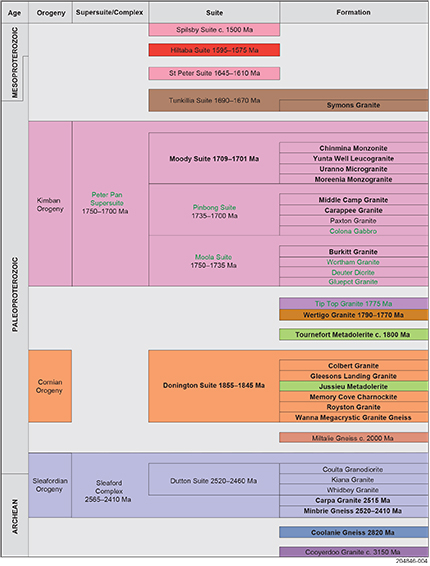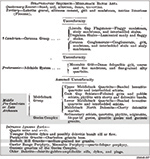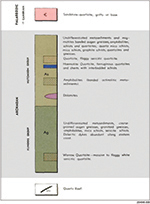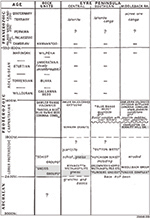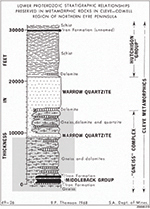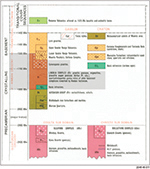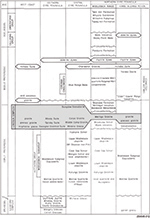Wayne M Cowley1, 2, Stacey O McAvaney1 and Claire E Wade1
1 Geological Survey of South Australia, Department of State Development
2 South Australia Stratigraphy Subcommission, Geological Society of Australia
Download this article as a PDF (1.6MB); cite as MESA Journal 82, pages 4–14
Figure 1 Map of Eyre Peninsula showing the extent of the Peter Pan Supersuite, Hutchison Group, basement units, and other mainly plutonic igneous units. Bold names indicate rocks originally grouped into the Lincoln Complex (at least in part); red names are new names applied to parts of the former Lincoln Complex. Tunkillia Suite occurs northwest of map extent.
Early mapping of the Gawler Craton on eastern Eyre Peninsula (Fig. 1) recognised the metasedimentary and igneous character of the rocks but struggled with the complex interleaving of gneissic, schistose, quartzitic and granitoid units (Parker 1993). An added complication was the geographic separation between the two main mapping areas: southern Eyre Peninsula and the Middleback Range. As a result, the metasediments were given a series of conflicting names such as Warrow Series or Hutchison Series (Tilley 1921), Middleback Group (Miles 1954; App. 1.1), Schist Group or Hutchison Group (Johns 1961; App. 1.2), and Dutton Metamorphics or Hutchison Metamorphics (Whitten 1966a, b; App. 1.3). The more gneissic and granitoid units were variously described as being basement to, intrusive into, and/or higher grade equivalents of, the metasediments and were termed Dutton Series and Flinders Series (the latter including the Lincoln and Sleaford gneisses; Tilley 1921), Gneiss Complex (Miles 1954; Thomson 1969), Gneiss Group or Flinders Group (Johns 1961) and Flinders Gneiss (Whitten 1966a, b). Johns (1961) went so far as to suggest that none of the gneissic or granitic-appearing rocks were true magmatic rocks, instead attributing them to intense migmatitic or metasomatic ‘granitisation’ of metasediments. Without the assistance of radiometric dating, all these rocks were at this stage considered Archean. Thomson (1969) additionally described the total metasedimentary succession (both schistose and gneissic) simply as Cleve Metamorphics, excluding subsequent intrusive igneous elements which were not named (App. 1.4).
Following detailed mapping on central Eyre Peninsula (Parker 1978), southern Eyre Peninsula (Mortimer 1984; CM Fanning in Parker et al. 1988) and in the Middleback Range (unpublished mapping by N Lemon, BHP Ltd) emphasising structural relationships, the stratigraphy of the metasediments was redefined as Hutchison Group (Parker and Lemon 1982; Parker 1993). K–Ar, Rb–Sr and U–Pb geochronology (Cooper et al. 1976; Webb and Thomson 1977; Webb et al. 1986) was also important in unravelling the complex intrusive history and the relationships of the gneissic rocks to the metasediments. Some gneisses were as a result shown to represent Archean to early Paleoproterozoic basement to the metasediments, while others were younger Paleoproterozoic intrusives, also frequently deformed.
A complex of predominantly granitoid rocks, interpreted as intrusives into both the metasediments and their basement, are widely exposed on Eyre and Yorke peninsulas and offshore islands. These rocks were first grouped and named as Lincoln Complex by Thomson (1980; App. 1.5) and considered to be emplaced over the broad interval 1800–1530 Ma during the Kimban Orogeny, first named (as Kimban Phase) by Thomson (1969). Parker, Fanning and Flint (1985) introduced a number of new stratigraphic names for Lincoln Complex intrusive bodies (App. 1.6). Later, three temporally, tectonically and geochemically distinct granitoid suites were identified in the Lincoln Complex: Donington Granitoid Suite c. 1840 Ma, slightly younger Colbert Suite and Moody Suite c. 1740–1710 Ma (Fig. 2; Parker 1993). The term Lincoln Complex has also been applied loosely since to undated deformed granitoid occurrences across the broader Gawler Craton, often on a purely lithological basis.
Hoek and Schaefer (1998) emphasised that the Donington Granitoid Suite and Colbert [Granitoid] Suite represented a distinct intrusive event, c. 100 million years older than the remainder of the Lincoln Complex. This led to their recommendation that the term ‘Lincoln Complex’ spanning these widely separated events be abandoned and the timing and duration of the Kimban Orogeny be restricted to the interval 1740–1700 Ma. Several volcano-sedimentary successions (Parker 1993; Ferris, Schwarz and Heithersay 2002; Hand, Reid and Jagodzinski 2007) including the Hutchison Group (at least in part; Reid and Hand 2012) were deposited in the Gawler Craton between these two events, which therefore cannot be genetically linked.
Schwarz (1998, 2003) subsequently included Colbert Suite (as Colbert Granite) within Donington Granitoid Suite, and Schwarz (2003) simplified Donington Granitoid Suite to Donington Suite.
Ongoing geochronology and geochemistry (e.g. Fanning 1997; Fanning, Reid and Teale 2007; Fraser and Neumann 2010) has allowed better separation of intrusive and metamorphic events, and has prompted formal abandonment of the term Lincoln Complex (Cowley, McAvaney and Wade 2016a, b; Fig. 3). The youngest phase (1750–1700 Ma) of the former Lincoln Complex is now the Peter Pan Supersuite (Wade and McAvaney 2016, in prep. a, b), applying to intrusives of the refined Kimban Orogeny. Three suites are recognised: the existing Moody Suite (Schwarz 1999) and two newly defined suites (Wade and McAvaney in prep. a; Fig. 3). The oldest former Lincoln Complex phase, Donington Suite (1850–1845 Ma, Cornian Orogeny; Reid and Hand 2008) remains a standalone unit. Several other units assigned to the former Lincoln Complex are now placed either into the younger Tunkillia Suite or into the Archean–Paleoproterozoic basement of the metasediments, comprising Sleaford Complex (Wade and McAvaney 2016), Coolanie Gneiss and recently named Cooyerdoo Granite (McAvaney 2012; Fig. 3). Other units occupy the 90 million year gap between the Donington Suite and the Peter Pan Supersuite, where magmatism had not been previously confirmed on Eyre Peninsula (McAvaney, Wade and Jagodzinski 2016; Fig. 3).
Figure 3 Stratigraphic table of major intrusive units of the Gawler Craton following abandonment of the Lincoln Complex. Named units formerly subunits of the Lincoln Complex are highlighted in bold; note how the units have been distributed into several distinct stratigraphic positions. Rocks now included in Cooyerdoo Granite were previously considered part of the Lincoln Complex but were only named following their exclusion. Newly defined units are in green text.
The Geological Survey of South Australia and the South Australia Stratigraphy Subcommission are in the process of abandoning the term Lincoln Complex, and replacing it with new terminology as evolving geochronology and geochemistry allows more precise correlations. Tilley’s (1921) term ‘Lincoln Gneisses’ was the first use of the name ‘Lincoln’, and the decision was made to abandon this name altogether to make a clean break from long-standing previous usage. Incorporation of the necessary changes to the Geological Survey’s SA Geodata stratigraphic database and SA Geology corporate map GIS has been a challenging task, which is only partly implemented. Although the stratigraphic database acts as a validation table for other records in SA Geodata, and for attributes of geological polygons, only some of the changes could be made in a global sense. Other updates will require careful assignment of new stratigraphy to these records and polygons on a geographic and geological basis individually or as subsets.
Appendix 1: Evolution of Lincoln Complex nomenclature
Appendix 1.1
Stratigraphic table from Miles (1954), showing probable units (shaded grey) which later were included in the Lincoln Complex.
Appendix 1.2
Portion of reference from LINCOLN 4-mile map included in Johns (1961). Note that there is no clear distinction of felsic intrusive rocks in the basement, so the units within the grey shaded area which later were included in the Lincoln Complex are not identified.
Appendix 1.3
Stratigraphic reference adapted from Whitten (1966b). Note that there is generally no clear distinction of felsic intrusive rocks in the basement, so the units which later were included in the Lincoln Complex (shaded grey) are uncertain.
Appendix 1.4
Stratigraphic sketch from Thomson (1969) for the Cleve-Cowell region. The units which later were included in the Lincoln Complex would be within the grey shading, but are not separately delineated.
Appendix 1.5
Portion of map reference from Thomson (1980). The Lincoln Complex as introduced here, together with other units within grey shading, is essentially the understanding which persisted until abandonment. By now, the Sleaford Complex basement was well established.
Appendix 1.6
Stratigraphic table from Parker, Fanning and Flint (1985). Note that here the Spilsby Suite is included in the Lincoln Complex (shaded grey), but later dating revealed that it is much younger.
References
Cooper JA, Fanning CM, Flook MM and Oliver RL 1976. Archaean and Proterozoic rocks on southern Eyre Peninsula, South Australia. Journal of the Geological Society of Australia 23:287–292.
Cowley WM, McAvaney SO and Wade CE 2016a. Abandonment of the Paleoproterozoic Lincoln Complex, Gawler Craton, South Australia. Australian Earth Sciences Convention 2016, Abstracts, Abstracts 118. Geological Society of Australia, p. 96.
Ferris GM, Schwarz MP and Heithersay P 2002. The geological framework, distribution and controls of Fe-oxide and related alteration, and Cu-Au mineralisation in the Gawler Craton, South Australia, Part I: geological and tectonic framework. In TM Porter ed., Hydrothermal iron oxide copper-gold and related deposits: a global perspective, Vol. 2. PGC Publishing, Adelaide, pp. 9–31.
Fraser GL and Neumann NL 2010. New SHRIMP U-Pb zircon ages from the Gawler Craton and Curnamona Province, South Australia, 2008-2010, Record 2010/16. Geoscience Australia, Canberra.
Hand M, Reid AJ and Jagodzinski L 2007. Tectonic framework of the Gawler Craton, South Australia. Economic Geology 102:1377–1395.
Hoek JD and Schaefer BF 1998. Palaeoproterozoic Kimban mobile belt, Eyre Peninsula: timing and significance of felsic and mafic magmatism and deformation. Australian Journal of Earth Sciences 45(2):305–313.
Mortimer GE 1984. Early to middle Proterozoic granitoids, basaltic dykes and associated layered rocks of southeastern Eyre Peninsula, South Australia. PhD thesis, University of Adelaide.
Parker AJ 1978. Structural, stratigraphic and metamorphic geology of lower Proterozoic rocks in the Cowell/Cleve district, eastern Eyre Peninsula. PhD thesis, University of Adelaide.
Parker AJ, Fanning CM and Flint RB 1985. Geology. In CR Twidale, MJ Tyler and M Davies eds, Natural history of Eyre Peninsula, Occasional Publications 4. Royal Society of South Australia, pp. 21–45.
Parker AJ, Fanning CM, Flint RB, Martin AR and Rankin LR 1988. Archaean-early Proterozoic granitoids, metasediments and mylonites of southern Eyre Peninsula, South Australia, Specialist Group in Tectonics and Structural Geology Field Guide Series 2. Geological Society of Australia.
Parker AJ and Lemon NM 1982. Reconstruction of the early Proterozoic stratigraphy of the Gawler Craton, South Australia. Journal of the Geological Society of Australia 29:221–238.
Reid AJ and Hand M 2012. Mesoarchean to Mesoproterozoic evolution of the southern Gawler Craton, South Australia. Episodes, 35(1):216–225.
Thomson BP 1969. Precambrian crystalline basement. In LW Parkin ed., Handbook of South Australian geology. Geological Survey of South Australia, Adelaide, pp. 21–48.
Thomson BP comp. 1980. Geological map of South Australia, 1:1 000 000 Maps of South Australia Series. Geological Survey of South Australia, Adelaide.
Tilley CE 1921. The granite-gneisses of southern Eyre Peninsula and their associated amphibolites. The Quarterly Journal of the Geological Society of London 77:75–134.
Wade CE and McAvaney SO 2016. Palaeoproterozoic syn-tectonic magmatism on Eyre Peninsula: insights from new geochemistry and geochronology of the Peter Pan Supersuite. Australian Earth Sciences Convention 2016, Abstracts, Abstracts 118. Geological Society of Australia, p. 452.
Wade CE and McAvaney SO in prep. a. Geochemistry of the Peter Pan Supersuite, Report Book 2016/00026. Department of State Development, South Australia, Adelaide.
Wade CE and McAvaney SO in prep. b. Neoarchaean to earliest Palaeoproterozoic magmatism in the southern Gawler Craton: petrogenesis of the Carpa Granite and Minbrie Gneiss, Report Book 2016/00019. Department of State Development, South Australia, Adelaide.
Webb AW and Thomson BP 1977. Archaean basement rocks in the Gawler Craton, South Australia. Search 8:34–36.
Webb AW, Thomson BP, Blissett AH, Daly SJ, Flint RB and Parker AJ 1986. Geochronology of the Gawler Craton, South Australia. Australian Journal of Earth Sciences 33:119–143.
Whitten GF 1966a. Geology of South Australian iron deposits. MSc thesis, University of Adelaide.


